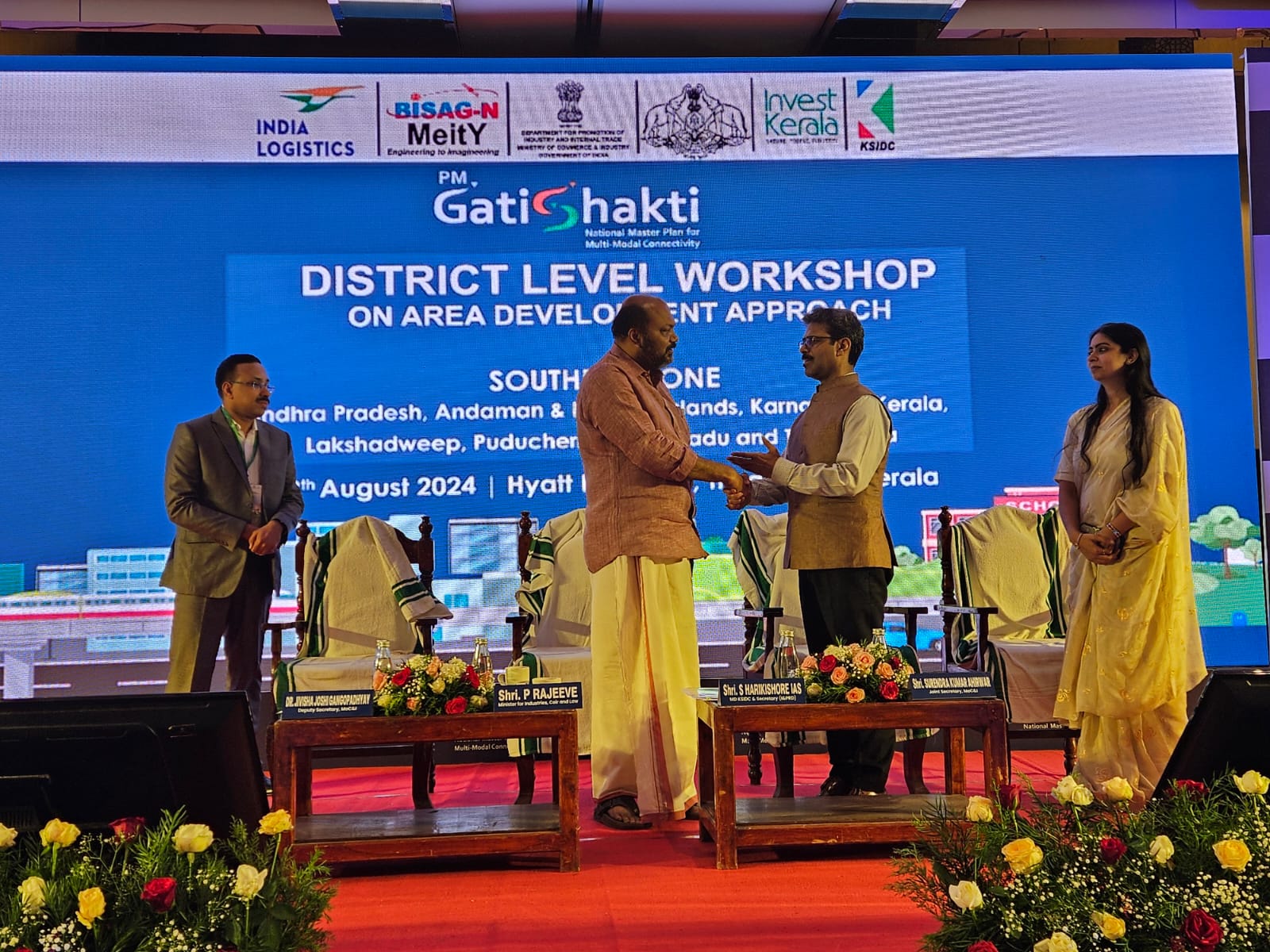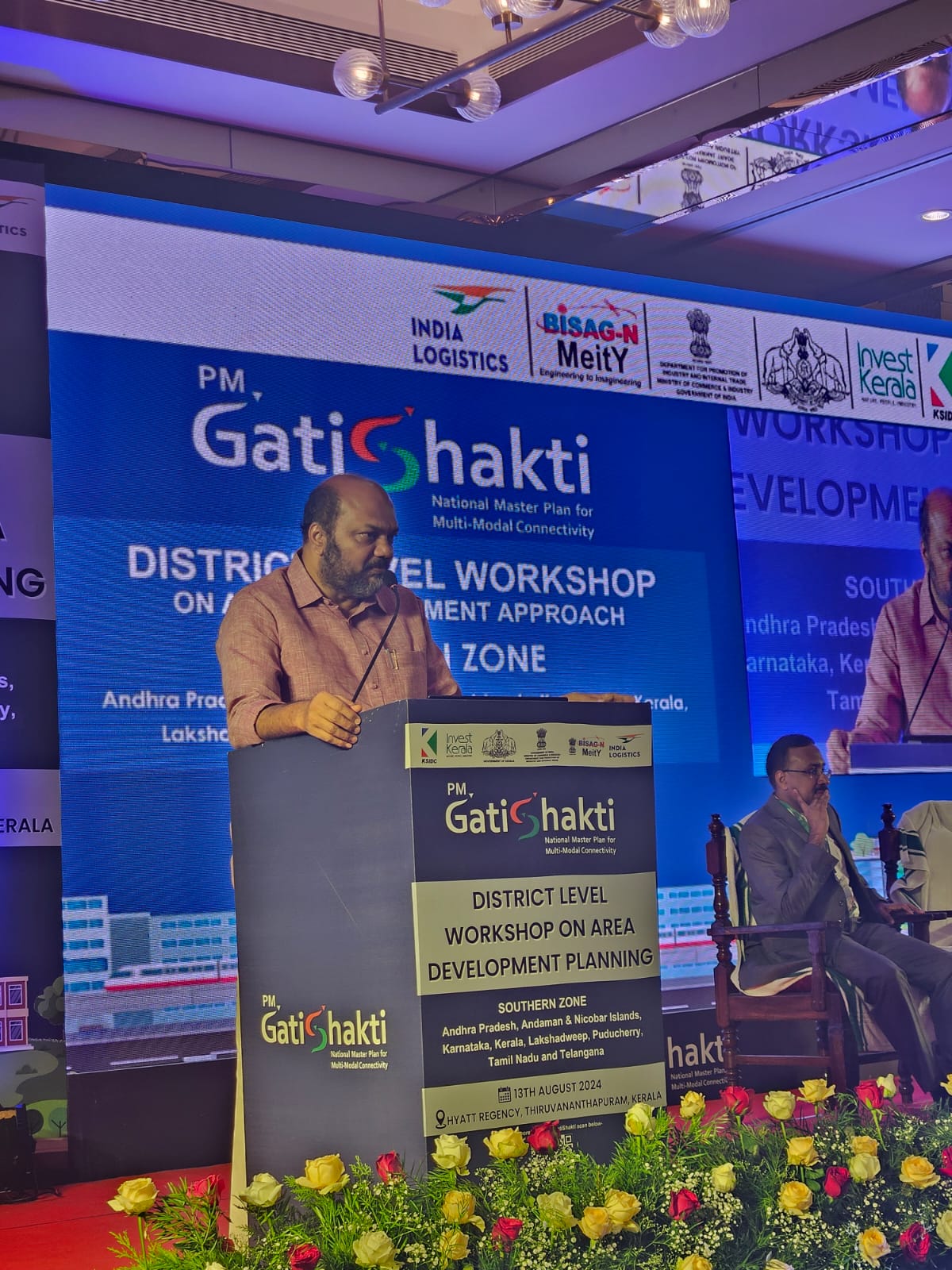
PM GatiShakti Southern Zone District Level Capacity Building Workshop held in Thiruvananthapuram
THIRUVANANTHAPURAM : PM GatiShakti (PMGS) National Master Plan (NMP) was launched by the Hon’ble Prime Minister on October 13, 2021, to facilitate integrated multimodal connectivity using indigenous technology. Its framework includes an inter-ministerial mechanism at both the Centre and State levels, along with a GIS-based decision support system, enhancing infrastructure planning and development across the country.
Since its launch, PMGS NMP has seen successful use cases from various Infra and Social sector Ministries and States/UTs, leading to the adoption of an ‘Area Development Approach’ for holistic planning. Effective economic and social infrastructure planning requires extensive information at the State, UT, and district levels. District Collectors, with their deep understanding of local challenges and priorities, are essential for verifying data and implementing the PMGS framework at the district level.
In the endeavour to take PMGS to the district/local level, Logistics Division with the technical support of BISAG-N is organising a series of seven pan-India district-level workshops, covering more than 100 districts. District level outreach is expected to give vigour to Area Development Planning for both economic and social infrastructure at field level in the country.
The first district level capacity building workshop was held in Bhopal (Central Zone- Chhattisgarh and Madhya Pradesh) on 18th January 2024. The second workshop was held in Pune (Western Zone- Maharashtra, Gujarat and Rajasthan) on 9th February 2024.
The third District level workshop was held in Thiruvananthapuram (Southern Zone) with 175+ participants from Central Ministries, State Governments and District level officials of 14 districts from Andhra Pradesh, Kerala, Karnataka, Tamil Nadu and Telangana, representing Infrastructure and Social Sectors Departments including planning, industries, education, forest, zila parishad, Aspirational block, panchayat, revenue, water and land. Officials from Puducherry, Andaman & Nicobar Island and Lakshadweep also participated virtually in the workshop.
Shri P. Rajeeve, Hon’ble Minister for Industries, Coir, and Law for the Government of Kerala graced the occasion and emphasized that PMGS NMP is enabling decentralized planning by taking into account the geographical and topographical advantages and limitations, supported by various datasets including data on land records mapped on the portal. He urged that officers across State Departments and Districts in the Southern States should leverage the portal for planning multimodal connectivity at ports and airports, internet connectivity, training institutes, disaster preparedness etc.
Sh. Rajesh Kumar Singh, Secretary DPIIT in his special address highlighted that mapped data such as landslide zones, demographics, elevation, flood-prone areas, schools, hospitals, transportation networks, warehouses, telecommunication networks, emergency landing sites, and soil conditions on the PM GatiShakti NMP can be extremely valuable for disaster management. This data will enable district officials to make informed, data-driven decisions during emergencies. He encouraged district officials to map the data on the District Mater Portal, which is expected to launch by the end of September 2024.
The event was inaugurated by Sh. A P M Mohammed Hanish, Principal Secretary, Industries, Kerala, Sh. Surendra Kumar Ahirwar, Joint Secretary, DPIIT (Logistics) and Sh. S. Harikishore, MD, Kerala State Industrial Development Corporation (KSIDC) along with other officers. Principal Secretary, Industries, Kerala highlighted that utilizing the PMGS NMP for planning can significantly enhance growth in the social sector, improve disaster preparedness, and facilitate multimodal connectivity in the region. To achieve this, active engagement at the grassroots level is essential, making the roles of district collectors crucial in identifying the unique priorities, challenges, and characteristics of their districts and hence utilise the GIS portal for area development planning in efficient manner. Joint Secretary, DPIIT underscored the scale and scope of PMGS NMP and encouraged district officers to adopt the portal for infrastructure and socio-economic planning.



During the workshop, (i) best practices and use cases of PMGS, by BISAG-N and various Infrastructure and Social Sector Ministries/Departments [such as M/o Road, Highway and Transport, Ministry of Ports, Shipping and Waterways (MoPSW), M/o Telecom, D/o School Education and Literacy] were showcased, (ii) Vizhinjam port as a special use case of PMGS NMP was also presented. By leveraging the portal and data, the port is expected to enhance multimodal connectivity, maritime trade, reduce logistical bottlenecks, and provide a significant boost to the regional economy. (iii) PMGS’s geo-spatial technology and Area Development Approach, with NITI Aayog’s aspirational districts program, to facilitate collaboration and better planning was dovetailed. (v) Utility of PMGS NMP platform in effective planning of infra, social and economic facilities and the role of District Collectors in facilitating comprehensive area-based planning was emphasised.
During the workshop, district collectors from Thiruvananthapuram & Ernakulum (Kerala), Parvathipuram Manyam, Alluri Sitharamaraju & Y.S.R Kadapa (Andhra Pradesh), and Asifabad, Bhoopalapally & Bhadradri-Kothagudem (Telangana) highlighted potential areas for infrastructure and social sector development using the portal. Some examples of potential use cases includes a) smart freight planning for city-level logistics planning, urban flooding preparedness and traffic & waste management in Ernakulum b) planning multimodal connectivity at the Vizhinjam International Seaport and road connectivity in coastal and remote areas in Thiruvananthapuram c) alignment of proposed highways [Chilakapalem-Ramabhadrapuram- Rayagada road, Calingapatnam-Srikakulam- Parvathipuram and Gara-Alkam-Bathili Road] and tourist activities in Parvathipuram Manyam using the portal d) Planning tourism and social infrastructure (Schools, Anganwadi centers, PHCs, CHCs, Health and wellness centers) in Kumuram Bheem Asifabad e) planning infra connectivity around industrial hubs in Y.S.R Kadapa district. Other districts who participated in the event included Virudhnagar, Ramanathapuram (Tamil Nadu) and Raichur, Yadgir (Karnataka). District collectors elucidated that apps like Call-Before-U-Dig (CBuD) are aiding in preventing damage to underlying assets like optical fibre cables that occurs because of uncoordinated digging and excavation.
Hands on training were also held to sensitize the particpants about benefits of PM GatiShakti including identification of area development use cases fully connected to all weather roads, facilities of power, internet, drinking water, etc. The workshop served as an effective means for bringing together relevant stakeholders of the PM GatiShakti NMP for extensive deliberations and cross learnings between Districts, States/ UTs and Central Ministries/Departments.
As a way forward to further enhance the impact of PM GatiShakti adoption at district level, Joint Secretary, DPIIT added that with the support of BISAG-N, creation of individual district-level portals (District Master Plan), login credentials of District Nodal Officers, and enrichment of NMP/SMP with district level data layers, training and capacity building, development of tools, use cases, would be undertaken through the relevant State PM GatiShakti units and the Industries Departments. District Master Plan portal on PM GatiShakti NMP would facilitate district-level project planning by addressing isolated planning issues, availability of huge data layers of Central and States Ministries/Departments, promoting an integrated and holistic approach in planning.
